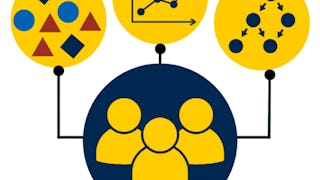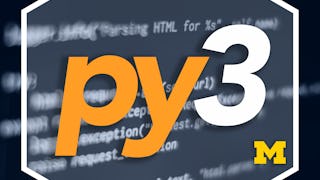In “Applied Information Extraction in Python,” you will learn how to extract useful information from free-text data, which is a type of string data created when people type. Examples of free-text data include names of people or organizations, location information such as cities and zip codes, or other elements like stock prices or clinical diagnoses. Free-text data is found everywhere, from magazine articles to social media posts, and can be complex to analyze.



Applied Information Extraction in Python
This course is part of More Applied Data Science with Python Specialization

Instructor: VG Vinod Vydiswaran
Included with 
Recommended experience
What you'll learn
Develop skills to process and interpret information presented in free-text data.
Identify the major classes of named entity recognition (NER) and implement, with guidance, state-of-the-art machine learning techniques for NER.
Compare, contrast, and select between multiple machine learning and deep learning approaches for NER.
Explore Large Language Models and configure a Transformer-based pipeline to extract entities of interest from a text dataset.
Skills you'll gain
Details to know

Add to your LinkedIn profile
June 2025
14 assignments
See how employees at top companies are mastering in-demand skills

Build your subject-matter expertise
- Learn new concepts from industry experts
- Gain a foundational understanding of a subject or tool
- Develop job-relevant skills with hands-on projects
- Earn a shareable career certificate

There are 4 modules in this course
This module introduces information extraction, covering key tasks and approaches for extracting relevant information from text. You will explore pattern-based and list-based methods to identify and extract information from text data, applying these techniques across diverse domains. You will also develop an end-to-end NLP pipeline to extract named entities from free text using terminology resources.
What's included
7 videos5 readings3 assignments1 programming assignment1 discussion prompt1 ungraded lab
In Module 2, you'll dive into the world of named entity recognition (NER). You'll learn to define and identify named entities, and understand how to tackle related tasks by framing them as NER challenges. We'll explore how to use resources like standardized terminology and named gazettes to enhance NER. You'll also gain hands-on experience by training a machine learning model for sequence classification using an annotated text dataset. Finally, we'll discuss the pros and cons of different Markov models for NER, equipping you with the insights needed for practical applications.
What's included
7 videos6 readings4 assignments1 programming assignment1 ungraded lab
In Module 3, focused on neural network models, you will explore the differences between training deep learning models and traditional machine learning models. You'll learn how to model and train a neural network-based classifier, as well as formulate text as features for NER model training. We will discuss the pros and cons of deep learning approaches. You'll design a neural network model to identify concepts from free text and apply a trained deep learning model to solve NER tasks.
What's included
5 videos4 readings4 assignments1 programming assignment1 ungraded lab
In this module, you'll dive into the power of deep learning models in diverse fields such as healthcare and sports commentary. You'll learn how to build neural network models that are fine-tuned for specific tasks and discover how to set up a deep neural network for detecting key entities. We'll also introduce you to the world of large language models, showcasing their transformative capabilities and applications in information extraction.
What's included
5 videos4 readings3 assignments1 programming assignment
Earn a career certificate
Add this credential to your LinkedIn profile, resume, or CV. Share it on social media and in your performance review.
Instructor

Offered by
Explore more from Machine Learning
 Status: Free Trial
Status: Free TrialUniversity of Michigan
 Status: Free Trial
Status: Free TrialUniversity of Michigan
 Status: Free Trial
Status: Free TrialUniversity of Michigan
 Status: Free Trial
Status: Free TrialUniversity of Michigan
Why people choose Coursera for their career





Open new doors with Coursera Plus
Unlimited access to 10,000+ world-class courses, hands-on projects, and job-ready certificate programs - all included in your subscription
Advance your career with an online degree
Earn a degree from world-class universities - 100% online
Join over 3,400 global companies that choose Coursera for Business
Upskill your employees to excel in the digital economy
Frequently asked questions
To access the course materials, assignments and to earn a Certificate, you will need to purchase the Certificate experience when you enroll in a course. You can try a Free Trial instead, or apply for Financial Aid. The course may offer 'Full Course, No Certificate' instead. This option lets you see all course materials, submit required assessments, and get a final grade. This also means that you will not be able to purchase a Certificate experience.
When you enroll in the course, you get access to all of the courses in the Specialization, and you earn a certificate when you complete the work. Your electronic Certificate will be added to your Accomplishments page - from there, you can print your Certificate or add it to your LinkedIn profile.
Yes. In select learning programs, you can apply for financial aid or a scholarship if you can’t afford the enrollment fee. If fin aid or scholarship is available for your learning program selection, you’ll find a link to apply on the description page.
More questions
Financial aid available,

